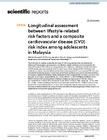| dc.contributor.author | Thangiah, Nithiah | |
| dc.contributor.author | Su, Tin Tin | |
| dc.contributor.author | Chinna, Karuthan | |
| dc.contributor.author | Jalaludin, Muhammad Yazid | |
| dc.contributor.author | Mohamed, Mohd Nahar Azmi | |
| dc.contributor.author | Majid, Hazreen Adbul | |
| dc.date.accessioned | 2024-01-30T12:02:19Z | |
| dc.date.available | 2024-01-30T12:02:19Z | |
| dc.date.issued | 2021 | |
| dc.identifier.citation | Thangiah, N., Su, T. T., Chinna, K., Jalaludin, M. Y., Mohamed, M. N. A., & Majid, H. A. (2021). Longitudinal assessment between lifestyle-related risk factors and a composite cardiovascular disease (CVD) risk index among adolescents in Malaysia. Scientific Reports, 11(1), 19135. https://doi.org/10.1038/s41598-021-98127-0 | en |
| dc.identifier.issn | 2045-2322 | |
| dc.identifier.uri | https://aecc.archive.knowledgearc.net/handle/123456789/253 | |
| dc.description | Available under License - Creative Commons Attribution: https://creativecommons.org/licenses/by/4.0/ | en |
| dc.description.abstract | The study aims to create a composite risk index of CVD among adolescents and examine the influence of demographic, socioeconomic and lifestyle-related risk factors on the composite risk index of biological CVD risk factors among adolescents in Malaysia. A Malaysian adolescent cohort of 1320 adolescents were assessed at 13, 15 and 17 years. Seven biological CVD risk factors with moderate correlation were identified, standardized and averaged to form a composite CVD risk index. Generalised estimating equation using longitudinal linear regression was used to examine the effects of changes in adolescent lifestyle-related risk factors on the composite CVD risk index over time. From the ages 13 to 17 years, physical fitness (β = − 0.001, 90% CI = − 0.003, 0.00002) and BMI (β = 0.051, 95% CI = 0.042, 0.060) were significant predictors of attaining high scores of CVD risk. Female (β = 0.118, 95% CI = 0.040, 0.197), Chinese (β = 0.122, 95% CI = 0.006, 0.239), Indians (β = − 0.114, 95% CI = − 0.216, − 0.012) and adolescents from rural schools (β = 0.066, 95% CI = − 0.005, 0.136) were also found to be considerably significant. A more robust and gender-specific intervention programme focusing on healthy lifestyle (including achieving ideal BMI and improving physical fitness) need to be implemented among school-going adolescents. | en |
| dc.language.iso | en | en |
| dc.publisher | Scientific Reports | en |
| dc.title | Longitudinal assessment between lifestyle-related risk factors and a composite cardiovascular disease (CVD) risk index among adolescents in Malaysia | en |
| dc.type | Article | en |
| dc.identifier.doi | https://doi.org/10.1038/s41598-021-98127-0 | |
